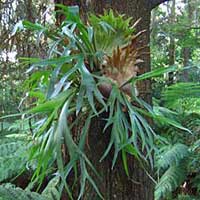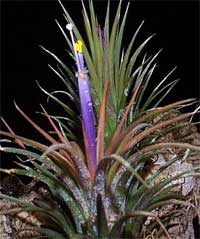Special ways of eating plants

Platycerium Fern
Platycerium Fern
Normally, plants use roots to suck up food in the soil, but ferns take food from the leaves. Its comb-shaped leaves make up tanks, used to collect other leaves that fall from the trees they live on. Decomposing itself in that natural basket, the leaves gradually turn into humus, making ferns. This plant is also called an epiphyte tree, which means it grows on the shell of another plant that is nourished indirectly and does not harm the host. The other leaves of ferns, smaller, perform photosynthesis and produce spores to maintain the race.
The tillandsia tree
The tillandsia tree, dubbed the "daughter of the air", rooted on a tree, and waited for a shower of rain.

The tillandsia tree
Its body and leaves covered a very thick network of scales filled with water. This amount of water is sucked up through a hole below each scale. Moreover, when water flows on trees, tillandsia absorbs mineral salts from the dead cells of plants.
Vascular plants
On Hierro Island, in the Canary Islands (Spain), a "misty sea" covers forests about 200 days a year. A legendary tree, called a vascular plant, exploits mist into water thanks to a unique method. Its broad leaves suck water from the condensed mist on the leaf surface before flowing along the branches. The tree is also responsible for self-irrigation work: the soil surrounding it is quickly absorbed. Until the 16th century, the indigenous Guanche people, exploiting the products of vascular plants, thanks to the open wells collecting its water. It is also known that other vascular plants live in arid but foggy areas, such as in the kingdom of Oman or Chile.
- 7 species of plants have special abilities like humans
- Whether or not Man-Eating Tree?
- Evolutionary defense system in earring plants
- 600 species of plants disappear, threatening human survival
- 8 ways to become immortal in ancient myths
- Interesting 'tricks' are used by plants during reproduction
- The work of creating 'super trees' supports human life
- Why do many unhealthy eaters live long?
- Surprised, she is nearly 80 years old and addicted to eating sand and gravel for 18 years
- Watercress 'prevents cancer'
- Stunned with plants possessing 'super powers'
- 'Carnivore'
 Why do potatoes have eyes?
Why do potatoes have eyes? 'Tragedy' the world's largest carnivorous life: Death becomes ... public toilet
'Tragedy' the world's largest carnivorous life: Death becomes ... public toilet Tomatoes were once considered 'poisonous' for 200 years
Tomatoes were once considered 'poisonous' for 200 years Detecting microscopic parasites on human face
Detecting microscopic parasites on human face